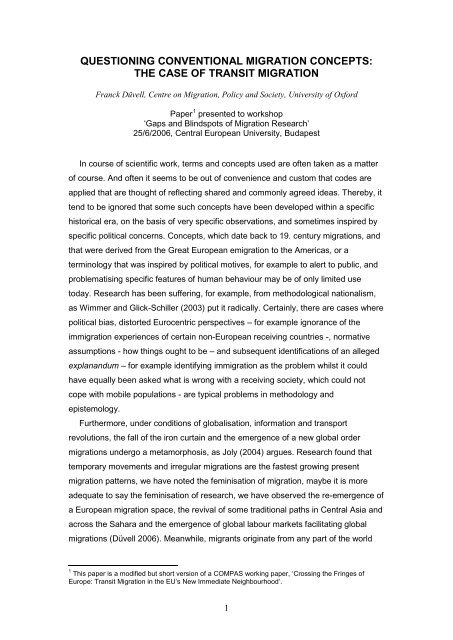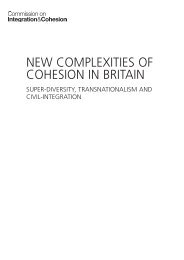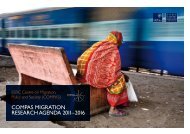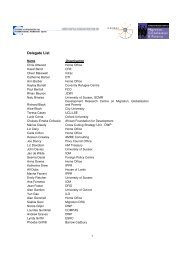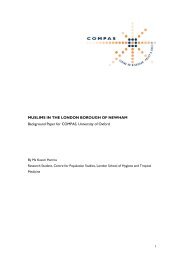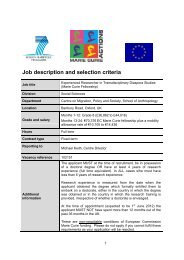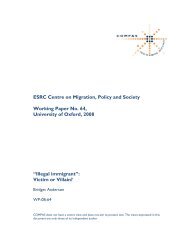questioning conventional migration concepts - COMPAS - University ...
questioning conventional migration concepts - COMPAS - University ...
questioning conventional migration concepts - COMPAS - University ...
Create successful ePaper yourself
Turn your PDF publications into a flip-book with our unique Google optimized e-Paper software.
QUESTIONING CONVENTIONAL MIGRATION CONCEPTS:THE CASE OF TRANSIT MIGRATIONFranck Düvell, Centre on Migration, Policy and Society, <strong>University</strong> of OxfordPaper 1 presented to workshop‘Gaps and Blindspots of Migration Research’25/6/2006, Central European <strong>University</strong>, BudapestIn course of scientific work, terms and <strong>concepts</strong> used are often taken as a matterof course. And often it seems to be out of convenience and custom that codes areapplied that are thought of reflecting shared and commonly agreed ideas. Thereby, ittend to be ignored that some such <strong>concepts</strong> have been developed within a specifichistorical era, on the basis of very specific observations, and sometimes inspired byspecific political concerns. Concepts, which date back to 19. century <strong>migration</strong>s, andthat were derived from the Great European e<strong>migration</strong> to the Americas, or aterminology that was inspired by political motives, for example to alert to public, andproblematising specific features of human behaviour may be of only limited usetoday. Research has been suffering, for example, from methodological nationalism,as Wimmer and Glick-Schiller (2003) put it radically. Certainly, there are cases wherepolitical bias, distorted Eurocentric perspectives – for example ignorance of theim<strong>migration</strong> experiences of certain non-European receiving countries -, normativeassumptions - how things ought to be – and subsequent identifications of an allegedexplanandum – for example identifying im<strong>migration</strong> as the problem whilst it couldhave equally been asked what is wrong with a receiving society, which could notcope with mobile populations - are typical problems in methodology andepistemology.Furthermore, under conditions of globalisation, information and transportrevolutions, the fall of the iron curtain and the emergence of a new global order<strong>migration</strong>s undergo a metamorphosis, as Joly (2004) argues. Research found thattemporary movements and irregular <strong>migration</strong>s are the fastest growing present<strong>migration</strong> patterns, we have noted the feminisation of <strong>migration</strong>, maybe it is moreadequate to say the feminisation of research, we have observed the re-emergence ofa European <strong>migration</strong> space, the revival of some traditional paths in Central Asia andacross the Sahara and the emergence of global labour markets facilitating global<strong>migration</strong>s (Düvell 2006). Meanwhile, migrants originate from any part of the world1 This paper is a modified but short version of a <strong>COMPAS</strong> working paper, ‘Crossing the Fringes ofEurope: Transit Migration in the EU’s New Immediate Neighbourhood’.1
and can be found in any part of the world illustrating the increasing globalisation of<strong>migration</strong>.In this light it seems appropriate to put <strong>conventional</strong> <strong>concepts</strong> on test, reassesstheir validity, take into account the specific historical circumstances under which aconcept or typology did become popular and to adjust definitions accordingly. Sincetypes and categories have often been identified through comparison it may well bethat the cases which have once been compared with have changed, or that a featureor pattern has disappeared. As a consequence, fresh comparison is required whichmay lead to fresh results. I would like to give you a few brief examples, giving you ataste of what I mean, before analysing the specific case of transit <strong>migration</strong> in greaterdebt.Sociologists in particular engage in identifying the order of things and tounderstand their interrelation and interaction. They develop classifications,taxonomies and typologies based upon ‘particular significant characteristics’(Durkheim 1895: 99). What is a significant characteristic is open to interpretation, anddepends on the perspective taken by the scholar. May I recall the famous metaphorof the half full/half empty glass? Usually, a pair of characteristics, a dichotomy isdeveloped and cases ordered accordingly, such as origin/destination, east/west,permanent/temporary, highly skilled/low skilled, forced/free, legal/illegal,internal/international, tourist/worker and so on. But is it not that often people orcountries slip between the categories, or are both at the same time, or that theymove from one stage to the other and back and that more cases fall in-between thedichotomous categories than actually match them?For example, we engage in distinguishing states by being e<strong>migration</strong> countriesand im<strong>migration</strong> countries. But is it not that almost all countries display more than justone feature? We have already accepted that Greece, Italy, Spain and Portugal havebecome countries of im<strong>migration</strong>, even though Portugal still is a country ofe<strong>migration</strong>. We have seen that Turkey has turned from an e<strong>migration</strong> country into acountry of e<strong>migration</strong>, im<strong>migration</strong> and transit, and simultaneously sending andreceiving refugees. Meanwhile, Czech Republic, once perceived a transit country hasbecome an im<strong>migration</strong> country too. Or if we look at Poland, we find that westernsources identify Poland as a sending country, whilst Ukrainian sources identifyPoland as a receiving country. That shows that different perspectives generatedifferent results. Related to this is the concept of east/west <strong>migration</strong>s perceived inthe west as the predominant pattern, whilst a blind eye is turned on east/east2
<strong>migration</strong>s, as from Ukraine to Russia, or to east/south movements as from Moldovato Turkey. All such observations require far more comprehensive research effortswhilst changes in <strong>migration</strong> patterns and directions require constant control of our<strong>concepts</strong>. Maybe, acknowledging the plethora of movements from and to diversedirections, such simplifications should be deconstructed and abandoned altogether.Migration figures, as it is the case with classifications, have to be checked andrecalculated, and the quality of the data set taken into account. For example, thefigure of 175 million international migrants is constantly repeated in the media and inacademic publications, even though recent GCIM reports (2005) illustrate that it islong outdated. Furthermore, it is acknowledged that temporary cross-bordermovements are of increasing relevance (OECD 2002), whilst irregular <strong>migration</strong> isthe ‘fastest growing form of <strong>migration</strong>’ (OECD 2001), but because <strong>conventional</strong>statistical methods are not geared up to reflect these movements, such figures mustbe treated with great caution. Furthermore, internal movements, even in largecountries such as Russia, India or China, or internally displaced people, are ignoredbecause they do not match the criteria of crossing an international border, yetanother example for the nationalist methodological bias. Taking into account all suchmovements we would come up with a very different figure for global human mobilityraising radically new questions about the human nature, the normality of <strong>migration</strong>.Finally, studies in illegal im<strong>migration</strong> usually find that immigrants enter on a visa,hence they are legal immigrants, but then they overstay or engage in illicit work andbecome irregular, but after a while they may regularise their status or they return andre-enter on a fresh visa. As a consequence, the legal status is a much more fluidthing that a simple dichotomy suggests.Enough examples, I would now like to discus the need for <strong>questioning</strong> some<strong>conventional</strong> and convenient <strong>concepts</strong> by taking the case of transit <strong>migration</strong>. Thethoughts I am presenting here are of very recent nature and represent work inprogress.Transit Migration - a politicised and blurred conceptThe emergence of the concept of transit <strong>migration</strong> is closely related to the fall ofthe Iron Curtain, EU accession and global economic integration, the turning up ofnew immigrants on European soil and the 1990s asylum crisis, or panic as somewould argue. It seems to have been invented in 1993, in course of a UN conferenceon that same topic, and by the International Organization for Migration (IOM) in 1994,3
following a (see references) series of papers, urging its member states to recognisetransit <strong>migration</strong> as an important pattern in international <strong>migration</strong>, and in particular inirregular and asylum <strong>migration</strong>. Widgren (1995), director of International Centre forMigration Policy Development (ICMPD), too was warning that at the height of theEuropean asylum panic most asylum seekers were transiting CEE countries. Transit<strong>migration</strong> has quickly become a policy issue, referred to in a 1998 strategy paper ofthe then Austrian presidency of the Council of the European Union emphasising, notfor the first time though, the importance of transit <strong>migration</strong> and transit countries. Thiswas responded by six action plans on Afghanistan, Sri Lanka, Iraq, Albania, Somaliaand Morocco, drafted by the High level Working Group on Asylum Migration (HLWG)in 1999, which put according emphasis on transit routes and transit countries. Morerecently, the ‘Ministerial Conference of the 5+5 Dialogue on Migration in the WesternMediterranean’ (2001) reemphasised the need for ‘joint management of thephenomenon’. The Council of Europe too has been engaged in related conferencesand processes, for example through its regional conference on ‘Migrants in TransitCountries’ in 2004, and thereby raising attention and encouraging national authoritiesto respond.The Emergence of the Concept of Transit MigrationMigration history has identified patterns of ‘transit <strong>migration</strong>’ long before it wascalled transit. Bade (2000: 151), for example, referred to Swedish observationswhereby young women first moved internally from countryside and villages to largertowns and port cities, where they worked in order to acquire the necessary funds forpaying the ship passage to America. He called that step-by-step <strong>migration</strong>. In earlieryears, similar movements have been understood as <strong>migration</strong> in stages (Treibel1990: 24). Past studies frequently found that, for example Turkish labour migrants inGermany have often moved internally from village to city before deciding forinternational <strong>migration</strong> (Kleff 1984). Furthermore, development studies and urbanstudies have for long been acutely aware of the link between rural-urban, henceinternal <strong>migration</strong> and international <strong>migration</strong> (e.g. Bilsborrow 1998). But becausesuch internal transit movement were not international <strong>migration</strong> sociology often doesnot see the link between the two. That may explain why a <strong>migration</strong> pattern whichhas for long been known to <strong>migration</strong> historians, geographers and developmentstudies did only enter the academic discourse of <strong>migration</strong> when it began to affectinternational movements.4
The concept of ‘transit <strong>migration</strong>’ finally seemed to have entered the <strong>migration</strong>policy discourse during the early 1990s (UN 1993; IOM 1994). Since then, it hasbecome increasingly applied if not popular. Transit <strong>migration</strong> is often identified withirregular <strong>migration</strong> and illegal employment and with human smuggling, trafficking andorganised crime. Typical terms or descriptions would be ‘illegal transit <strong>migration</strong>’, ‘ingeneral, transit migrants travel in groups and use the services of traffickers’(Sipavicieno and Kanopiene 1997: 9). For example, a UN publication identifies transit<strong>migration</strong>’ flows of irregular and illegal migrants from the Third World and from eastEuropean countries’ (International Migration Bulletin, 3, 11/1993: 7). In view of theparliamentary assembly of the Council of Europe (2001: 1) the ‘two majorcharacteristics of transit <strong>migration</strong> are its illicit nature and an elaborate criminalorganisation’ (see also ICMPD 2005a: 1). For ICMPD, the ‘Dialog on MediterraneanTransit Migration’ which they have been initiated is a direct consequence of their aimto ‘prevent irregular <strong>migration</strong>’(http://www.icmpd.org/default.asp?nav=budapest&folderid=362&id=-1).A literature survey reveals that transit <strong>migration</strong> is as much a discourse as it is ascientific concept. What becomes obvious though is that ‘transit <strong>migration</strong>’ hasbecome a code for ‘illegal im<strong>migration</strong>’, and for ineligible asylum seekers, whoaccording to the Dublin Convention are supposed to make their claim in the first safecountry instead of moving on. Accordingly, countries found to be transited bymigrants are thought of as problematic (GDISC 2006). Some publications presentedtransit <strong>migration</strong> as yet another threat to Europe. For example, the IOM (1994a)report on transit <strong>migration</strong> in Hungary engaged in notorious number games allegingthat up to two million migrants are living in Central Europe who wanted to move tothe West. Recently, again high and implausible figures circulate about millions ofsub-Saharan African transit migrants gathering in northern Africa trying to movenorth. 2 Basically all EU neighbours have been associated with transit <strong>migration</strong>.‘Transit <strong>migration</strong>’ has to some extent become sort of a war cry directed at countriesthat are expected by European Union countries to keep unwanted <strong>migration</strong> offEuropean territories.Unfortunately, rigorous academic research is scarce, few case studies have beenconducted focussing on Iranians (Kaytaz 2006), Iraqis (Danis et a. 2006) and West2 Personal conversation with Denise Holt, Foreign and Commonwealth Office, held at the occasion of ameeting at the UK embassy in Berlin. In this case transit migrants seem to have been confused withimmigrants, namely in Libya, whilst in fact most of the 1,2-1,8 million migrants in Libya are labourmigrants and only a minority can be considered transit migrants.5
Africans (Brewer and Yükseder 2006) in Turkey (Yaghmaian 2005, Icduygu 2005),Kurds in Greece (Papadopoulou), Somalis and Sudanese in Egypt (Roman 2005),Chinese in Russia (Ghelbras 2001), or Morocco (Haas 2005) as case studies.Obviously, more research is required in order to produce evidence-based findingsinstead of politicised conclusions.Despite widespread use, there does not exist a category or definition for transit<strong>migration</strong> in international law. Instead, such a definition has entered into political andacademic discourse by custom, as it seems. One of the earliest definitions has beenoffered by UN/ECE (1993: 7), whereby transit <strong>migration</strong> is ‘<strong>migration</strong> in one countrywith the intention of seeking the possibility there to emigrate to another country asthe country of final destination’. Meanwhile, IOM is also defining transit <strong>migration</strong> as‘refugees awaiting resettlement’ (IOM 2004: 53). Other sources define transit<strong>migration</strong> as ‘the stage between e<strong>migration</strong> and settlement’ (Papadopoulou 2005: 2).Several sources insist that transit <strong>migration</strong> is of often irregular nature (UN/ECE(1993: 7) or involve smuggling and trafficking (Council of Europe (2001, para 3; USState Department 2001). Such definitions are either particular narrow or rathervague; transit <strong>migration</strong> is confused with forced <strong>migration</strong>, illegal <strong>migration</strong> and withtrafficking. The invention of the concept is not free from political motivation, and it isuse is often politically loaded, if not negatively connoted. The way it is applied bysome international and intergovernmental organisations, is often grossly simplifying ifnot misleading. What was once meant to be a clear-cut category, aiming to raise theattention of <strong>migration</strong> control agencies instead turns out to be a complex,multifaceted and multidimensional <strong>migration</strong> pattern.A Complex and Problematic ConceptThe difficulties with the concept of transit <strong>migration</strong> are manifold. These will nowbe discussed in some detail.There is a certain and disturbing bias attached to the transit concept and that isthe assumption, that migrants from low-income countries who are found in, forexample, a middle-income country, such as Russia, Ukraine or Turkey, are inclinedto move on to high-income countries. This assumption seems to be informed byeconomic modelling, based upon the Todaro (1969) model, which is suggesting thatmigrants move to the destination which offers the highest return for their labour.Opposing this assumption is the fact that migrants in their majority instead move toneighbouring or nearby destinations, which are linked through regional <strong>migration</strong>6
systems (Düvell 2006). Instead of striving for maximum income improvement, asTodaro suggests, any improvement seems to serve as an incentive, whilst distance,language and culture, lack of social and human capital and general risk adversenessserve as disincentives for moving to a high-income but distant country.Meanwhile, it can be observed that countries that have for some time beenperceived as transit countries, such as the EU-8 countries, but also Turkey areacknowledged to be also countries of im<strong>migration</strong>. There is some plausibility inassuming that this has to do with increasingly rigid <strong>migration</strong> controls, regulationsand restrictions of western European countries which prevent migrants from movingfurther west and instead force them to settle where they are. This however, is asomewhat biased and short-sighted perspective. Not only that EU-8 countries havehigh growth rates, scarcities resulting from e<strong>migration</strong> and populations that areageing at an even faster pace than in western Europe leading to some demand formigrant labour. They also had distinct bilateral relations with sending countries, inparticular attracting students from many African and Asian countries. Thereby,specific <strong>migration</strong> channels have been introduced, which may well have developedinto distinct <strong>migration</strong> networks and even systems. Thereby, EU-8 countries are toointegrated into global <strong>migration</strong> movements, and into regional and intercontinental<strong>migration</strong> systems. Assuming that these countries cannot be countries of destinationbut must be transit countries, and assuming that im<strong>migration</strong> is to be solely explainedby the ‘stuck’ effect does not seem justified.A problematic dividing line to draw is that between transit <strong>migration</strong> and repeated<strong>migration</strong>. This seems to be the problem with some authors who interpret migrantswho move on to another country ‘transit’ even after a long stay in their first hostcountry (e.g. Roman 2006). In contrast, diverse evidence-based and inter-related<strong>migration</strong> theories – the theory on cumulative causation, culture of <strong>migration</strong> andaccumulation of <strong>migration</strong> experiences (see DaVanzo 1983, Massey and Zenteno1999, Massey and Zenteno 2001) found that an individual that has migrated once,and who has improved his/her human and social capital develops a higher propensityto migrate again. This could also affect on-<strong>migration</strong> from a first to a secondim<strong>migration</strong> country. On the other hand, as it has been observed in Turkey(McAnailly Burkey 1997) and in Greece (Jordan and Düvell 2001), repeated<strong>migration</strong> may be the consequence of frustrated experiences in the first country ofdestination, where lack of opportunities may result in considering to move on to morepromising destination. The distinction seems to be that repeated migrants who moveon to another country did not intend to do so in the first instance but only developedsuch an aspiration whilst staying in their first host country. It is unconvincing to define7
a migrant as in transit retrospectively, hence to mark periods in their live as transitorywhich lie before the point of time at which the decision to move on has been made. Incontrast, a migrant who would have the aspiration to move on to another countryfrom the day s/he arrived in their first host country could justifiably be understood atransit migrant.There are two very different aspects that lead researchers to the application of theconcept of transit <strong>migration</strong>. Either (A) a person, which is found in a given country isindeed transiting this country and in fact continues the journey, or (B) a person foundin a given country only intends to transit this country and plans to move on to a finaldestination. Whilst (A) is a matter of fact, (B) is an immigrant’s account, an intentionor maybe no more than a dream.That leads to considerable methodological concerns. As yet, most researchseems to have been conducted in what are perceived the transit countries.Consequently, the interviewees have not been met at the supposed end of their<strong>migration</strong> trajectory but somewhere in-between a supposedly longer <strong>migration</strong>project. Or perhaps not! At least such interviews do not provide satisfying evidencefor the concept of transit <strong>migration</strong>. What they reveal instead is a state of mind, amentally transitory process maybe. But is that not similar to findings related to theconcept of return <strong>migration</strong> where it was found that, for example, guest workers inGermany or Asian labour migrants in the UK, dreamed of a return to Turkey orPakistan, even after having spend most of their live in Germany or England? Returnrather became a ‘myth’ (Anwar 1979, Düvell 2006) than a realistic option. No onewould have concluded that individuals holding on to such a myth are in fact returnmigrants. Could it not be that the idea of being in transit and that the intention tomove on to the shinier destinations in Western Europe or the US is representing asimilar myth? Could it not be that, for example, that the 70 per cent of migrants whowere interviewed by IOM (1994a) in Hungary and who explained that they want tomove west were voicing a dream rather than having concrete plans? At least therealisability of such accounts cannot be taken for granted.Another set of literature is based upon an equally incomplete and biased set ofdata. Kosher (1997), Robinson and Segrott (2002) and Gilbert and Kosher (2004)studied asylum seekers in the UK in order to identify reasons, such as socialnetworks, that explain why these migrants have chosen the UK and how they havemanaged to come. These, however, only build upon those migrants who successfullymade it to the UK, hence those, whose trajectories can be retrospectively interpretedas transit <strong>migration</strong>. Neither does it consider those who were unsuccessful and who8
wanted to move on but stranded in a third country, nor is the context accuratelyconveyed in course of such post hoc narratives.Furthermore, there is considerable overlap, if not confusion of transit <strong>migration</strong>with asylum <strong>migration</strong> and with refugee resettlement, and with irregular <strong>migration</strong> andtrafficking. Empirically, it has been found that migrants who are restricted frommoving to Europe legally and who therefore turn to the services of human smugglersor fall into the hand of traffickers are often taken through a range of countries (e.g.Mavris 2002; Futo et al. 2005). Often they have to acquire further funds in order tofinance their journey and to pay consecutive smugglers in order to reach their nextstage. With respect to asylum, Papadopoulou (2005) challenges the separation ofasylum and <strong>migration</strong>; both are embedded in different discourses and policycontexts, whilst in fact there are common characteristics. In particular transit<strong>migration</strong> seems to be consisting of both irregular migrants and refugees.Finally, there is a set of related questions that illustrate the difficulties with thedefinition of the concept. How long, or short, is transit supposed to last to beinterpreted as transit <strong>migration</strong>? After which length of stay does ‘transit’ turn intoim<strong>migration</strong> or temporary <strong>migration</strong>? Is a highly skilled IT worker, doing a 12-monthjob in the UK and after that intending to move on to the US a transit migrant or is s/henot? Where to draw the line between transit <strong>migration</strong>, repeated <strong>migration</strong> and evenglobal mobility? Are migrants who are staying in one country for several years but stillinsist that they intend to reach a final other destination are really transit migrants?Would the discourse not be better advised to distinguish between actual transit<strong>migration</strong> and mental transit?To sum up this discussion and in order to justify the application of the concept oftransit <strong>migration</strong> to given <strong>migration</strong> patterns and intentions certain conditions shouldbe met:1. A person has the clear intention to move to a country of destination via atransit country.2. This clear intention existed prior departure from the country of origin.3. A person has the clear intention to move on from the country of his/herpresent stay to a final destination.4. A person is taking concrete steps to realize this aspiration, e.g. makingsavings, or otherwise preparing for the journey.5. A person has as a matter of fact arrived and settled at the final destination bytransiting another country.9
ConclusionTransit <strong>migration</strong> has become a hot topic on the <strong>migration</strong> policy agenda; it is aspoliticised as it is a policy discourse. Transit <strong>migration</strong> has equally become a codeword for ‘illegal im<strong>migration</strong>’ and for unwanted refugees. Efforts to combat illegal<strong>migration</strong> or unwanted refugees do in fact target transit <strong>migration</strong> and transitcountries. Two major principles can be identified that explain transit <strong>migration</strong>,protectionism, because destination countries and increasingly traditional transitcountries impose restrictions that provoke would-be migrants to make the strangest,and sometimes dangerous deviations in order to reach their destination; and class,because those migrants who are too poor to simply take a flight to their country ofdestination or to disguise their purpose by pretending to be tourists or businessmentake cheaper routes by foot, bus or train through other countries.Often, transit migrants are not in transit out of choice, nor is transit intended oreven planned; instead migrants are compelled to move on because their first countryof im<strong>migration</strong> turns out to be an impossible place to stay, for either legal andeconomic or for social reasons. And often, the choice of transit, or the choice of afinal country of destination only occurs in course of a <strong>migration</strong> trajectory. In somecases, transit may turn out to be repeated <strong>migration</strong> or global mobility instead.None of the critical questions raised here are meant to argue that there does notexist such thing as transit <strong>migration</strong>. There are ample observations, hints andevidences suggesting that transit <strong>migration</strong> is widespread and that numerouscountries do experience migrants transiting their territories. What has become clearthough is that the concept of transit <strong>migration</strong>, because of the difficulties andproblems that characterise the concept, requires evidence-based refinement andreinterpretation.ReferencesAnwar, Mohammad. 1979. The Myth of Return. Pakistanis in Britain. London: Heinemann.Bade, Klaus J. 2000. Europa in Bewegung. Migration vom späten 18. Jahrhundert bis zurGegenwart. Munich: C. H. Beck.Bilsborrow, Richard E. (ed). Migration, Urbanisation, and Development: New Directions andIssues. Norwell, Dordrecht: Kluwer.Brewer, Kelly: Yukseder, Deniz. 2005. The Unending Migration Process: Survival Strategiesof African Migrants in Istanbul “Waiting” to Leave for Europe. Paper submit to IMILCOworkshop, Istanbul,Bulletin Quotidien Europe. 2006a. EU to Help Spain Stem Flow of Illegal Migrants. 25/5/2006.Bulletin Quotidien Europe. 2006b. EU Sends Experts to Libya. 25/5/2006.Council of Europe. 2004. Final Communiqué. Regional Conference “Migrants in the transitcountries: sharing responsibilities in management and protection”. Istanbul.10
Council of Europe. European Committee on Migration. 2002. Towards a MigrationManagement Strategy. Strasbourg.Council of Europe, Parliamentary Assembly. 2001. Transit <strong>migration</strong> in central and easternEurope. Recommendation 1489. Strasbourg.Council of the European Union. 1998. Strategy paper on <strong>migration</strong> and asylum policy.9809/2/98. Brussels.Danis, Didem; Pérouse, Jean-François; Taragh, Cherie. 2006. Integration in limbo, Iraqi,Afghan and Maghrebi Migrants in Istanbul. Research report submit to Migration ResearchProgram, Koc <strong>University</strong>, Istanbul, see also http://www.ifea-istanbul.net/oui/ouiprogr.htm.Durkmeim, Emile. 1895. Les regles de la methode sociologiqie. Paris: Felix Alcan.Düvell, Franck. 2006. Europäische und internationale Migration. Münster: Lit.Düvell, Franck (ed.). 2005a. Illegal Im<strong>migration</strong> in Europe. Beyond Control. Houndmills:Palgrave/Macmillan.Futo, Peter; Jandl, Michael; Karsakova, Lija 2005. Illegal <strong>migration</strong> and human smuggling inCentral and Eastern Europe. Migracijske i etničke teme 21(1-2): 35–54.General Directors’ Im<strong>migration</strong> Conference. 2006. High-level summit on Ukraine, 22 February2006,Prague. http://www.gdisc.org/index.php?id=133&tx_gdiscdb_pi1[showUid]=23&cHash=5523c46bc8.Ghelbras, Vilia. 2001. The Chinese reality of Russia. Moscow: Muravey (in Russian).Gilbert, A.; Koser, Khalid. 2004. Information dissemination to potential asylum seekers incountries of origin and/or transit. Findings. London: Home Office.Global Commission on International Migration. 2005. Migrations in an interconnected world:new directions for action. Report of the GCIM. Genf:GCIM, www.gcim.org/en/finalreport.html.Haas, Hein de. 2005. Morocco’s <strong>migration</strong> transition: trends, determinants and futurescenarios. Global Migration Perspectives, no. 28. Genf: Global Comission onInternational Migration.Icduygu, Ahmet. 2005. Transit Migration in Turkey: Trends, Patterns, Issues. Florence:European <strong>University</strong> Institute.ICMPD. 2005a. Transit Migration – A Challenge for Migration Management. Presentation at13th OSCE Economic Forum, Prague, 23-27 May 2005.ICMPD. 2005b. What is the MTM Dialogue? Vienna: ICMPD.ICMPD. 2004. Irregular transit <strong>migration</strong> in the Mediterranean—some facts, futures andinsights. Vienna: ICMPD.Inter-Parliamentary Union. 2005. Migration and development. Geneva: IPU.IOM. 1993. Transit <strong>migration</strong> in Romania: Annex to the IOM study: Profiles and motives ofpotential migrants in Romania. Geneva: IOM.IOM. 1994a. Transit Migration in Hungary. Geneva: IOM.IOM. 1994. Transit <strong>migration</strong> in Bulgaria. Geneva: IOM.IOM. 1994. Transit <strong>migration</strong> in the Czech Republic. Geneva: IOM.IOM. 1994. Transit <strong>migration</strong> in Poland, Geneva: IOM.IOM. 1994. Transit <strong>migration</strong> in the Russian Federation. Geneva: IOM.IOM. 1995a. Transit Migration in Turkey. IOM.IOM. 1995b. Irregular Migration in Central Europe: the Case of Afghan Asylum Seekers inHungary. Geneva: IOM.IOM. 2003. Study on Transit Migration through Azerbaijan. IOM: Baku.IOM. 2004. Glossary on Migration. International Migration Law. Geneva: IOM.Ivakhniouk, Irina. 2004. Analysis of Economic, Social, demographic and Political basis ofTransit Migration in Russia – Moscow case. Paper presented to regional Conference on‘’Migration in Transit Countries: Sharing responsibility for management and protection’,Istanbul. Strasbourg: Council of Europe.Joly, Daniele (ed.). 2004. International <strong>migration</strong> in the new millennium: global movement andsettlement. Aldershot: Ashgate.Jordan, Bill: Düvell, Franck. 2002 Irregular Migration. Dilemmas of Transnational Mobility.Cheltenham: Edward Elgar.Kaytaz, Esra S. 2006. Turkey as a country of Transit Migration. MPhil Thesis. Oxford: Oxford<strong>University</strong>.Koser, Khalid. 1997. Social networks and the asylum cycle: The case of Iranians in theNetherlands. International Migration Review, 31(3): 591-612.11
Kleff, Hans-Günter. 1984. Vom Bauern zum Industriearbeiter. Zur kollektivenLebensgeschichte der Arbeitsmigranten aus der Türkei. Ingelheim: Manthano.Mavris, L. 2002. Human smugglers and social networks: transit <strong>migration</strong> through the statesof former Yugoslavia. Evaluation and Policy Analysis Unit, Refugee Research WorkingPaper, no. 72.. Geneva: UNHCR.Massey, Douglas; Zenteno, Rene. 2001. The dynamics of mass <strong>migration</strong>. Proceedings of theAcademy of Sciences, USA, 96: 5328-35.McAnailly Burkey, Molly. 1997. African in Turkey – the dark and the bride side. Turkish DailyNews, 1 January 1997, www.turkishdailynews.com/old_editions/01-02-97/feature.htm.Ministerial Conference of the 5+5 Dialogue on Migration in the Western Mediterranean. 2001.Tunis Declaration. Tunis, http://www.welfare.gov.it/NR/,accessed at 13/6/2006.OECD. 2002. International mobility of the highly skilled. Paris: OECD.OECD. 2001. SOPEMI. Trends in international <strong>migration</strong>. Annual Report 2000. Paris: OECD.Papadopoulou, Aspasia. 2005. Exploring the asylum-<strong>migration</strong> nexus: a case study of transitmigrants in Europe. Global Migration Perspectives No. 23. Geneva: Global Commissionon International Migration.Robinson, Vaughn; Segrott, J. 2002. Understanding decision-making of asylum seekers.Findings. London: Home Office.Roman, Howaida. 2006. Transit Migration in Egypt. CARIM research report. Florence:European <strong>University</strong> Institute.Sipavicieno, Audra; Kanopiene, Vida. 1997. Foreign labour in Lithuania: Im<strong>migration</strong>,employment and illegal work. International Migration Papers 31. Geneva: ILO.Todaro, Michael P. 1969. A Model of Migration and Urban Unemployment in Less-developedCountries. The American Economic Review, 59: 138-48.Treibel, Annette. 1990. Migration in modernen Gesellschaften. Soziale Folgen vonEinwanderung und Gastarbeit. Weinheim: Juventa.UN/ECE. 1993. International Migration Bulletin, No 3.US State Department. 2001. Trafficking in Persons report. Washington: StateDepartment, http://www.state.gov/g/tip/rls/tiprpt/2001/, accessed 13/6/2006.Widgren, Jonas. 1995. Towards Collective European Cooperation With Respect to theMovements of People. Vienna: ICMPD.Wimmer, Andreas; Glick-Schiller, Nina. 2003. Methodological nationalism, the social sciencesand the study of <strong>migration</strong>: An essay in historical epistemology. International MigrationReview, 37 (3): 576.Yaghmaian, Benzad. 2005. Embracing the Infidel. New York: Delacorte.12


